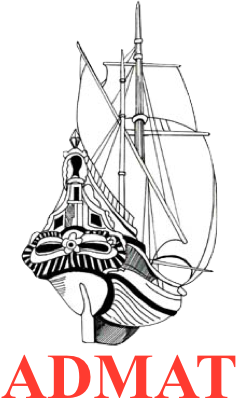A survey well done! ADMAT members Connor Grzesiak (Australia) and Dr Florence Prudhomme (France) after the last maritime archaeological survey dive, during the 2019 season on Le Dragon.
ADMAT Congratulates Dr Florence Emmanuelle Prudhomme on being awarded her PhD. Her thesis is on Le Dragon (scuttled on the north coast of the Dominican Republic in 1783) and her Captain.
Dr Florence Prudhomme, one of the first members of ADMAT and ADMAT-FRANCE and having been instrumental in assisting ADMAT commence its maritime archaeological work in the Dominican Republic in 2005, has been awarded her PhD in maritime archaeology and history at Sorbonne University in France. This is a major undertaking and all at ADMAT salute her in this epic achievement!
Following on from Dr Spooner’s PhD (2004) thesis which included the initial ground breaking research on Le Dragon, then called The Carron Wreck after the Scottish iron 9pdrs which were found on the wreck, Florence has spend the last 4 years researching the history of the ship and her Captain. Florence and Dr Francois Gendron of ADMAT-FRANCE discovered the identification of Le Dragon in the French archives in 2006 after using the forensic archaeological clues Dr Spooner found on the wreck site.
The history of this important ship, the spy on board, the King of France’s secret orders, Admiral Hood’s Caribbean Squadron with 21 blockading ships from Monte Cristi to Puerto Plata and the final one day battle between HMS Barfleur 98 gun flagship of Admiral Hood and HMS Invincible 74 which were engaging Le Dragon 20 guns, is an epic story. She was the last French warship lost in the American Revolutionary war in 1783. Forget the “Master and Commander” film this is the real story worthy of a Hollywood blockbuster!
Florence found the code to the cipher from the King of France’s secret orders to the French Governor of Santo Domingo (the Dominican Republic). This led the research to find the story and discover an “off-the-charts military and naval operation”, a “secret society” financed by the King of France who hoped to rule the Caribbean and the Americas after England had been defeated and the research eventually found that the Le Dragon was built as the Washington an American Privateer in 1776. She was one of the first ships fighting for the Continental Navy only to be captured later by the English and named Dragon and to be subsequently captured by the French and called Le Dragon. She fought under three flags which is rare!
A translated summary of Dr Prudhomme’s thesis is as follows:
Navigating in revolutionary times: chevalier de L’Espine (1759-1826) from the American Independence into the service of Austria. A destiny through the prism of Maritime archaeology and History.
At the very beginning of the 21st century, a team of archaeologists dived on the wreck of a small 18th century warship in the north of the current Dominican Republic. Its hull is of American manufacture, its guns are Scottish and the buttons of uniforms are French. After having followed some false leads, the research in the National Archives makes it possible to solve this enigma: it concerns the French corvette Dragon of Chevalier de L’Espine, destroyed in January 1783 after a short action against British vessels ensuring the northern blockade of Santo Domingo. This identification serves as a catalyst for a historical research of which Chevalier Joseph de L'Espine du Puy (1759-1826) constitutes the central character. The investigation reveals the fate of the Navy officer L'Espine upstream and downstream of his gallant action in January 1783. Young Knight of Malta and officer of the Navy of Louis XVI, L'Espine participated in the American Revolution, did a mandatory service in the Navy of Malta, and took part in French naval intelligence secret missions. The French Revolution ruined his hopes and forced him into exile. In Austria, he won the confidence of the high Austrian authorities by unambiguously engaging with the armies of France from 1795. L'Espine quickly became one of the brains of an Austrian Navy questioned at each treaty signed between France and Austria. Promoted to Feldmarschall-Leutnant in 1813, L'Espine decided not to return to France at the Restauration. Appointed Governor of Milan in November 1825, he died there on December 31, 1826.
Soutenue le 13-09-2019

